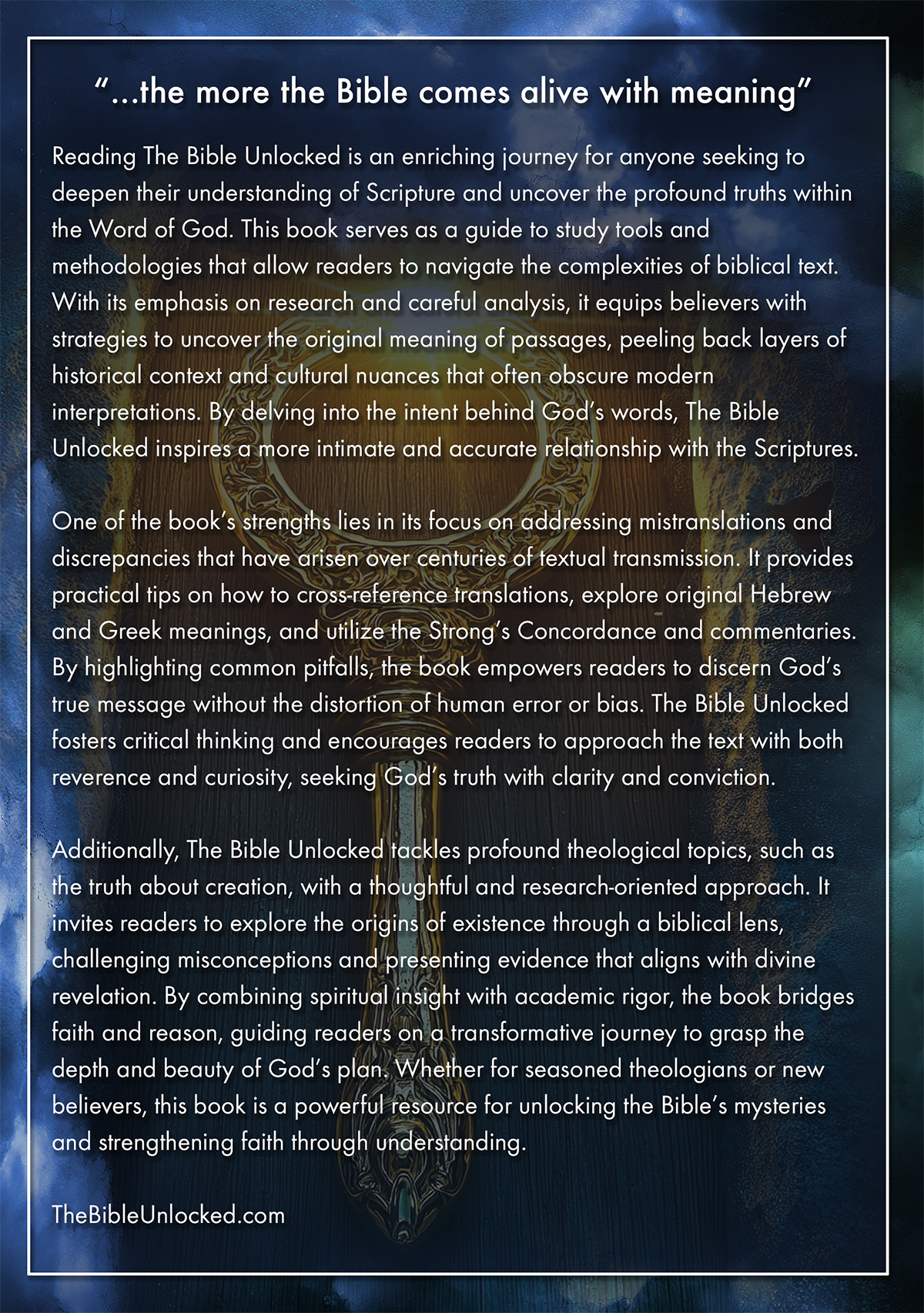

"...the more the Bible comes alive with meaning"
Reading The Bible Unlocked is an enriching journey for anyone seeking to deepen their understanding of Scripture and uncover the profound truths within the Word of God. This book serves as a guide to study tools and methodologies that allow readers to navigate the complexities of biblical text. With its emphasis on research and careful analysis, it equips believers with strategies to uncover the original meaning of passages, peeling back layers of historical context and cultural nuances that often obscure modern interpretations. By delving into the intent behind God's words, The Bible Unlocked inspires a more intimate and accurate relationship with the Scriptures.
CHAPTER 3
Knowing Satan’s intentions, God issued the first commandment in the Garden of Eden: “But of the fruit of the tree which is in the midst of the garden, God hath said, Ye shall not eat of it, neither shall ye touch it, lest ye die.”
The tree in the midst of the garden was known as the Tree of Knowledge of Good and Evil, and it symbolically referred to Satan.
Throughout the Bible, trees were used as symbols, just as the serpent was used as symbolism for Satan in the Book of Genesis. The Bible is filled with symbolic elements. Taking these symbolic elements literally often leads to mistranslations, confusion, improper teachings, and false religions.
Satan, being cunning, devised a plan to disrupt and attempt to stop the seed line of Jesus Christ. According to the Bible, he “beguiled” Eve as part of this attack.
In the original language, the word “beguiled” implies that Satan “wholly seduced” Eve. In other words, Satan had sexual relations with her. This is why God declared:
“I will put enmity between thee and the woman, and between thy seed and her seed; it shall bruise thy head, and thou shalt bruise his heel.”
To clarify, let’s rewrite this passage with the definitions derived from the original language:
I (God) will put enmity (hatred and division) between thee (Satan) and the woman (Eve), and between thy (Satan’s) seed (offspring, progeny, or descendants) and her seed (the seed passed to Eve through Adam); it (Jesus) shall bruise thy (Satan’s) head (a future prophecy), and thou (Satan) shalt bruise his (Jesus’s) heel (fulfilled when Jesus was crucified, and a spike was driven through His heel).
For further clarity:
God will place hatred and division between Satan and Eve, and between Satan’s offspring and Adam and Eve’s descendants. Through Adam and Eve will come Jesus, who will bruise Satan’s head. In turn, Satan will bruise Jesus’s heel, as fulfilled during the crucifixion when a spike was driven through His heel.
When Satan beguiled Eve, he became the father of Cain. This is supported by six Scriptures that validate Satan’s paternity of Cain. One of these references is the verse cited above, spoken directly by God.
It’s worth noting that many struggle with the idea of Satan having sexual relations with Eve, yet readily accept the notion of a talking serpent and the myth of Eve biting into an apple, despite the fact that the Book of Genesis never mentions an apple.
Keep in mind, a male child was included in Biblical genealogies only if he had offspring (descendants/children). Knowledgeable scholars generally agree on this. Despite Cain having descendants, in the Book of Genesis, he is notably absent from Adam’s genealogy.
Abel is also missing from Adam’s genealogy, but for a different reason. Abel had no descendants, because he was murdered by his brother Cain. Seth was the first child of Adam and Eve to have offspring, making him the first to appear in Adam’s genealogy as the pure bloodline leading to Jesus Christ.
Now let’s think about what Jesus said when teaching a lesson about good versus evil. Jesus told us to learn the Parable of the Fig Tree. He talked about good figs and bad figs, and about wheat and tares. Jesus said the wheat represented God’s children, and the tares represented the children of the devil.
The more an individual studies, the more evident it becomes that Eve had sexual relations with Satan first, which fathered what the parable called the tares. After that, Eve had sexual relations with Adam, which fathered what the parable called the wheat. As a result, Satan was the father of Cain, while Adam was the father of Abel.
In addition, Cain’s genealogy is listed first, while Adam’s genealogy is listed second, in the Book of Genesis. Cain’s descendants were called Kenites, a term in the original languages meaning “offspring of Cain.”
If Jesus told us to learn about the good figs and bad figs, and about the wheat and tares, wouldn’t it make sense for the Bible to show the family trees (the bloodline) of both groups? Common sense tells us that the wheat came from Adam’s family line through Seth, and the tares came from Cain’s family line through Satan.
If some people still want to believe Cain was Adam’s son, they have free will to think as they want. As always, I recommend using the research tools recommended earlier to find the true answer.
In summarizing the events of the Garden of Eden, the birth of Cain and Abel reveals specific details. Eve gave birth to Cain and then “continued” to give birth to Abel, as correctly translated. This indicates that Cain and Abel were fraternal twins, specifically a rare case of heteropaternal superfecundation, where two eggs are fertilized by sperm from two different fathers.
The true events of the Garden of Eden have often been described by scholars as too complex to teach, especially to young children. To simplify matters, traditions created the well-known but inaccurate story of Eve eating an apple. Unfortunately, many still believe this oversimplified narrative.
Consider Adam’s statement about Eve: “She gave me of the tree, and I did eat.” This phrase has been the subject of scholarly debate.
One interpretation suggests that Satan deceived Adam into believing he was a woman, leading Adam to engage in sexual relations with him.
Another interpretation suggests that Adam engaged in homosexual intercourse with Satan, which would have been an abomination to God.
Another perspective says Adam simply touched Satan, thereby violating God’s law. The interpretation one chooses ultimately depends on individual study and reflection. Due to the complexity of these interpretations, the more familiar story of Adam partaking in the forbidden fruit, commonly represented as an apple, was adopted for easier teaching.
It is crucial to approach traditional stories with discernment, as they can sometimes be misleading. Always conduct thorough research, using reliable tools and resources, when confronted with potentially deceptive accounts.
The story of Adam and Eve’s transgression, eating from the Tree of Knowledge of Good and Evil, which symbolized Satan, represents the first recorded sin in the Old Testament. Their act violated God’s first commandment.
Notably, when Adam and Eve became aware of their sin, they covered themselves with fig leaves. Consider the symbolism: if the sin had been the simple act of eating an apple, they might have covered their mouths. Instead, they covered their genital areas, suggesting that their sin was of a sexual nature.
As a result of this sin, death was introduced to humanity. The Bible records that early human lifespans extended for hundreds of years, but over time, these spans shortened, eventually stabilizing at 40, 70, or 120 years per generation.






